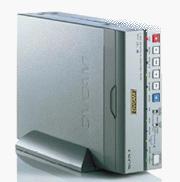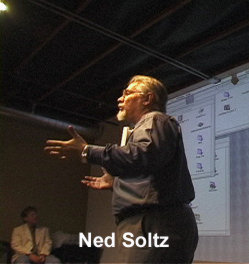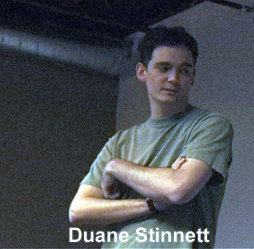Every
once in awhile
the lafcpug will dedicate a night to new users of NLE and FCP
and tonight was the night. An overflow crowd sat wide eyed as
we did our best to explain the difference between a ripple delete
and a dimpled chad, a slip edit and Ford Explorer tire issues.
Well, that part was easy but the rest of it gave all of us new
users a heck of a lot to digest once we get home to our new pal,
the fcp workstation.
Meeting began at 6:30PM
with the introduction of FCP Gurus Ralph Fairweather from 2-pop.com and and Cinematographer Andrew Balis,  both
of whom urgently walked to the front of the room, stared into
the eyes of the audience and dared them to ask questions on what,
if any, FCP problems they were encountering. And wouldn't you
know it, a lot of problems there were. Some of which I recount
here using the indecipherable notes taken by Doug Lindeman. Dr
Rawstock FCP instructor, Jim
Foreman also
joined Ralph and Andrew in answering questions.
both
of whom urgently walked to the front of the room, stared into
the eyes of the audience and dared them to ask questions on what,
if any, FCP problems they were encountering. And wouldn't you
know it, a lot of problems there were. Some of which I recount
here using the indecipherable notes taken by Doug Lindeman. Dr
Rawstock FCP instructor, Jim
Foreman also
joined Ralph and Andrew in answering questions.
Question: What causes dropped frames?
Answer: (Ralph) User error. Next question.
Question: I use a VX2000 for capture and
I keep getting audio distortion problems once it's into FCPs
timeline. What's up with that?
Answer: (Jim) Assuming your recorded sample rate is the
same as your capture rate, your audio might be too hot. Lower
your overall level in the time line 7 dbs. Using cameras as decks
for playback and capture are not as forgiving as decks them selves.
Seems to be something in the mechanism of the cameras.
Answer: (Andrew) Huh?
Question:How can I monitor my audio levels
capturing via Firewire?
Answer: (Andrew) Get external VU meters.
Answer: (Ralph) Yeah. I was going to say that.
Question: I did these titles in FCP and
then when I transferred the movie to VHS the titles which were
in white broke up and looked really grey. How come?
Answer: (Andrew) You used non NTSC safe colors and thats
what is happening. If you don't have Photoshop than set your
saturation levels to no more than 85%. Otherwise do your titles
in Photoshop and use their NTSC safe colors and import back into
FCP.
Answer: (Ralph) Blacks and Whites are too intense for
NTSC. You can use a "legalizer" but they are expensive.
PS settings for white output should be no lower than 16 for black
and no higher than 235 for white.
Question: I get these damned dropped frames
during playback. Why? It's really got me bugged.
Answer: (Ralph) User error.
Answer: (Andrew) Well, it could be fragmented hard drive,
not enough ram, incorrect settings, overlapping windows, corrupt
files, lots of things.
Answer: (Ralph) User error
Meeting was called to
order at 7:15 PM. Joseph
O'Connor asked
members to help him for an upcoming seminar he his doing at UCLA
on behalf of the LA Digital Media Center. Those who want to show clips of their work
cut on FCP should contact Joe ASAP. He also gave details about
very low cost FCP training that the media center is doing at
Pasadena City College. Write Joe for more information on this.
We also decided to have Decembers' meeting on the 13th and devote
the entire night to Show and Tells and spiked egg nog. More details
on this in a couple days.
Our first Presenter of
the night was Jim Foreman,  chief
technologist (whatever that is) and head FCP instructor at Dr
Rawstock. Jim
took us all through the adventures of editing in the timeline
and did so in record time. He covered the tool palette, the Viewer
and Canvas Window, the 134 buttons in the windows and the 134
ways to mark an in and out point. Ok, so I exaggerate, but there
are many ways to do this, and Jim showed us how. We got a demo
with the help of Doug Lindeman on the difference between the
various types of edits. Using three sheets of paper, we got a
nice visual picture of just what is the difference between a
slip, slide, roll, ripple, insert, replace, overwrite edit. Awkward
terminology made simple via three sheets of paper.
chief
technologist (whatever that is) and head FCP instructor at Dr
Rawstock. Jim
took us all through the adventures of editing in the timeline
and did so in record time. He covered the tool palette, the Viewer
and Canvas Window, the 134 buttons in the windows and the 134
ways to mark an in and out point. Ok, so I exaggerate, but there
are many ways to do this, and Jim showed us how. We got a demo
with the help of Doug Lindeman on the difference between the
various types of edits. Using three sheets of paper, we got a
nice visual picture of just what is the difference between a
slip, slide, roll, ripple, insert, replace, overwrite edit. Awkward
terminology made simple via three sheets of paper.
Jim brought up the trim
edit window and spent a few minutes on that. He covered some
keyboard short cuts. L cuts, split edits, markers, and even nesting.
(For me, Nesting will have to be a 45 minute demo. I still don't
get it.) He even brought up the Yak, the coolest Easter egg in
any app.
Not enough time but a real good overview of editing in FCP timeline
and well, I learned a lot.
First show and tell of the night was from Jeff Reese  who
got us all laughing with a clip from his "mockumentary"
The Final Moo, the story of the last days of a childrens television
show and the dysfunctional Minnesota family that produces it.
(All show and tells tonight were first time FCP projects in keeping
with our "Salute to Newbies" night.)
who
got us all laughing with a clip from his "mockumentary"
The Final Moo, the story of the last days of a childrens television
show and the dysfunctional Minnesota family that produces it.
(All show and tells tonight were first time FCP projects in keeping
with our "Salute to Newbies" night.)
Shot on High 8 film and edited in FCP and making extensive use
of graphics, and VO, Jeff tells us he is planning on entering
this movie into film festivals and we wish him big time luck.
Go check out a clip on the Final Moo web site. Thanks Jeff and
great beginning for ya.
Next up was our good
friend Cawan Starks form
Promax
with a few very cool toys from Sony and Panasonic to show off.
First was the Sony DSR-11 VTR
which is a mini-DV,
form
Promax
with a few very cool toys from Sony and Panasonic to show off.
First was the Sony DSR-11 VTR
which is a mini-DV, DVCam, NTSC and
PAL format deck in one. Quite probably a DSR-20 killer, this
deck is small, portable and does the dishes.
DVCam, NTSC and
PAL format deck in one. Quite probably a DSR-20 killer, this
deck is small, portable and does the dishes.
The AG-DV1000
from Panasonic is a real cool mini-dv
deck that will flag 16:9, adjust audio levels, has s video in
and out and VU meters. It also does the dishes.
is a real cool mini-dv
deck that will flag 16:9, adjust audio levels, has s video in
and out and VU meters. It also does the dishes.
But the one toy that
had everyone drooling was the Sony DSR-50
 mini
DV, DVCam, (mini and full size) VTR that will read PAL, has 26
pin component I/O, XLR, audio adjust in, will start TimeCode,
copy TimeCode, run on Batteries, wash your dishes, AND raise
your children. This is the deck I want for Christmas. Please
send check too...
mini
DV, DVCam, (mini and full size) VTR that will read PAL, has 26
pin component I/O, XLR, audio adjust in, will start TimeCode,
copy TimeCode, run on Batteries, wash your dishes, AND raise
your children. This is the deck I want for Christmas. Please
send check too...
Thanks Cawan for making us drool and Promax for giving us the
opportunity to touch these things.
So we were about 40 minutes behind at this point when I brought
up our crack treasurer and FCP guru Ned Soltz for a demonstration on FCPs Title Generator.
So Ned got up and turned to the audience and said, "Don't
use it. Get Boris Graffiti. Thank you."
This of course was not on the schedule so after negotiations
Ned reluctantly, but with the enthusiasm of the pro that he is,
gave us an excellent tour on doing titles in Photoshop and THEN
bringing those titles into FCP. (Good compromise, I think) Ned
says it's just a lot easier and you can make sure your titles
are "safe and legal" using Photoshop safe colors. In
FCP you have to guess. He gave us a demo on how to make titles
transparent, told us to make sure we set our window to 720X534
and 72dpi, do our titles, and when we finish, change to 720X480
for import back to FCP.  He told
us of Ken Stones excellent article
on doing Credit Rolls and Titles in PS which offer numerous advantages
over the limited capabilities of FCP.
He told
us of Ken Stones excellent article
on doing Credit Rolls and Titles in PS which offer numerous advantages
over the limited capabilities of FCP.
He then went into FCP and imported what he created in PS and
gave us a few more tips and tricks but time was running short
and I forced to cover Neds mouth with tape and beg him to stop
so we could all take a well deserved break. And so we did. Thanks
Ned for your wonderful enthusiasm and sorry about that PowerBook
mouse.
First up after a 15 minute
break was FCP pioneer, creator of the FCP PowerStart CD, Instructor
for the DV Revolution Workshop, and President of DVCreators.net, Josh Mellicker. When
does this guy sleep?
Josh is not only one of the countries most knowledgeable FCP
experts, but he is also one of the most knowledgeable video camera
experts. So instead of having him grace us with more FCP know-how
we had him give us a how-to on using a DV camera to make your
movie look a little less "video looking."
Josh started off giving us a brief tour of the cameras controls
using a Canon GL1.
With the camera pointed to the audience, and the resulting image
projected on the screen, Josh played around with the aperture,
shutter,and sharpness controls. Each control giving a distinct
"look" to your video. Josh recommends you leave your
shutter speed at 1/60 unless you are photographing fast moving
objects. Play with the aperture but keep it wide open for shallow
depth of field. Just move the camera back and zoom in. Works
pretty well. The sharpness control will give you a cool look
depending on what level you set it. Try it out. There are lots
of possibilities here.
Josh then borrowed a member of the audience and had him sit in
a chair and showed us a down and dirty and fast way of achieving
nice lighting using an inexpensive Lowel To Go light kit. It's OK to have shadows, says
Josh. 
He showed us the look that a black
pro mist filter will
give you. He played with gels and the overall look, at least
on the projector, was very UN video like. Real cool.
Josh gave us tips on making our own lighting kits using what
you can get from Home Depot. He showed us a clip from a soon
to be released video dvcreators.net is producing. We got a lot
of info in a very short time and I can't imagine even the most
seasoned pro not picking up something useful here. Really good
stuff and I encourage you to go to dvcreators.net and hang around for more info.
Josh will definitely be coming back many times to the lafcpug.
Our next show and tell
was from Brian
and Rose Wilson
with their parody of "The Perfect Storm" called "The
Really Bad Storm."  Shot
in one day, this very funny short with a well made score was
edited on FCP and told the story of a group of men going off
to get fish in really bad weather. The stories about shooting
this movie are as funny as the movie. But then, aren't they all.
The budget was said to be under $1,000,000. the movies composer
was Mark
Justin. Thanks
Rose and Brian for a great time and very funny movie.
Shot
in one day, this very funny short with a well made score was
edited on FCP and told the story of a group of men going off
to get fish in really bad weather. The stories about shooting
this movie are as funny as the movie. But then, aren't they all.
The budget was said to be under $1,000,000. the movies composer
was Mark
Justin. Thanks
Rose and Brian for a great time and very funny movie.
Actor/film maker Nick
Jameson was up
next. His very first project using FCP was his actors "demo
reel"  A one minute, MTV
style fast cut compilation of several of his TV and movie appearances.
With really cool use of titles generated in FCP, and a bit of
the Knoll Lens Flare thrown in for good measure this was one
damn fine first effort. It just goes to show you; Actors make
the best directors. <g> Nick is off and running now doing
other projects with FCP and hopefully he will show us some of
what he's doing.
A one minute, MTV
style fast cut compilation of several of his TV and movie appearances.
With really cool use of titles generated in FCP, and a bit of
the Knoll Lens Flare thrown in for good measure this was one
damn fine first effort. It just goes to show you; Actors make
the best directors. <g> Nick is off and running now doing
other projects with FCP and hopefully he will show us some of
what he's doing.
Director Duane Stinnett came on up and showed us clips
from his short film, "The Curio Trunk." The story of
an elderly couple who buy this trunk for a vacation only to discover
the trunk has a secret. And a dark one at that.  Photographed
by Andrew
Balis and shot
on 35 mm film this comedy/horror/thriller left us wanting more.
Big question of the night was, "What the hell is in the
trunk?" Great work Duane and we can't wait till it comes
out so we can find out.
Photographed
by Andrew
Balis and shot
on 35 mm film this comedy/horror/thriller left us wanting more.
Big question of the night was, "What the hell is in the
trunk?" Great work Duane and we can't wait till it comes
out so we can find out.
World famous raffle was
next and while I was getting things together, Ned Soltz begged
to show a clip of what I thought were FCP titles, but was a clip
of my appearance on NBCs "Titans" last week. Of course
Ned had to change the sound track a bit to keep interest high,
but luckily several empty coke cans were thrown at the screen
by various members of the audience and we cut the clip short.
We want to thank Lowell
Kay, Jim Foreman, Joseph O'Connor, Josh Mellicker, Lisa Brenneis,
and Promax for the following donations to our raffle.
Raffle Winners:
3 TDK mini DV tapes - Chris Teed
3 TDK mini DV tapes - Anthony Scarpa
Visual Quickstart Guide - Barbara Simon
Promax T-shirt - Phil Gray
Dr Rawstock T-shirt - Tony Scarpa
Promax T-shirt - Roger
Visual Quickstart Guide - Val Kuklowsky
Dr Rawstock T-shirt - Dabling Harwood
Promax Dual Head Card, (DH-MAX) - Phil Nee
Power Start CD - Ned Soltz
Power Start CD - Fae Kuen
Free Dr Rawstock 3 day boot camp - Ben Dent
Free DV Revolution Workshop - Roger Phillips
Thanks to all of you
for showing up and see you December
13th for our
first annual Show and Tell/film festival/Christmas party.
Michael Horton
HeadCutter